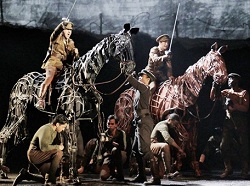
Last year, James Miller reviewed War Horse for CultureCatch. Now, with interest in the show growing after the recent release of the movie, which is up for six Oscars, C. Jefferson Thom weighs in with a dissenting opinion.
What is it about animals that pulls on our sense of compassion? An invading alien army can spend the better part of a disaster film evaporating countless numbers of people, but as long as a single dog escapes its death rays there’s a collective sign of relief. Are animals somehow easier to love and care for? War Horse would certainly suggest that this is the case.
Letting it all ride on its horses, the creators of War Horse have underestimated the importance of a good story and solid characters, transfusing every ounce of development and significance from the speaking Homo sapiens to their silent equine counterparts. This gamble seems inspired by the amazing work of Handspring Puppet Company, but even their unprecedented skills of magical animation are unable to leap the barbed wire of a weak script and its muddled message.
Andrew Durand does a serviceable job in the role of Albert Narracott, trudging through a minefield of agonizing dialog and paper-thin foils to recover his horse in this role-reversal telling of The Incredible Journey. There are several other actors in the play and a number of criticisms to be made about poor accents, mugging, and lackluster performances, but as the piece does not seem to concern itself much with these players’ existences, it seems appropriate that neither should we. Instead, these complaints should be filed fairly.
Writer Nick Stafford’s awareness of the play’s intended focus on its breathtaking puppetry seems readily apparent, and if there were any moving human stories or profundities in Michael Morpurgo’s original story, then they were most certainly lost in Stafford’s hasty translation. Too many characters are introduced only to then exit, serving little purpose other than giving the horses someone to interact with. With the slight exception of Albert there are no human characters to care about in the piece because they simply don’t exist. Human moments are pushed through in hopes of moving quickly to the more engaging steed-related visuals. Cheap jokes and other abysmal attempts at humor try to compensate, but the lame language-barrier gags don’t hold up well in the trenches. Directors Marianne Elliott and Tom Morris do nothing to curb these unfortunate qualities, but rather compound them with uneven directing as well as allowing for a schizophrenic score which can’t decide whether it’s being written for a play or a movie soundtrack.
Handspring Puppet Company, its puppets and their technicians, who would be more justly termed artists, are the only clear prizewinners in this pony show. From the thrill of a thundering gallop to the subtle twitch of an attentive ear, these puppeteers bring a living, breathing horse in abstraction to the stage and, despite the lack of flesh and hide, leave little doubt that there is a heart pumping blood inside of this magnificent beast. As performance art, these horses could stand on their own without a half-baked play getting in the way, and it can only be hoped that Handspring will land work more worthy of their awe-inspiring abilities in the future.
Whatever it is that emotionally draws us to other animals is a beautiful thing, but if it takes sympathy for the plight of a horse to open our eyes to the horrors of war and the pain and suffering that we cause one another as human beings, then the word "humanity" might not be something to get too excited about.
